Experimental Investigation of Fatigue Capacity of Bending-Anchored CFRP Cables
Abstract
:1. Introduction
2. Materials and Methods
2.1. Materials
2.2. Design and Fabrication of Bond-Friction Anchor for CFRP Rod Specimen
2.3. Design and Fabrication of CFRP Cables for Fatigue Testing
2.4. Fatigue Testing Setup for CFRP Rod and Cable
- Mode I: Unaffected strength and stiffness;
- Mode II: Reduced strength and unaffected stiffness;
- Mode III: Fatigue failure (defined as a 30% reduction in stiffness in this study).
2.5. AE Setup for Monitoring the CFRP Rods and Cables
3. Results and Discussion
3.1. Fatigue Resistance of the CFRP Rod under the Axial-Fatigue Loading
3.2. Macroscopic Fatigue-Damage Modes and Damage Progression in CFRP Cables
3.3. Spatial Distribution of Macroscopic Fatigue Damage Caused to CFRP Cables
3.4. Material-Scaled AE Monitoring of Fatigue Damage of CFRP Rod
3.5. Component-Scaled AE Monitoring on Fatigue Damage of CFRP Cable
4. Conclusions
- Experimental results indicate that after the fatigue cycles of two million, the residual strength retention rate of the CFRP rod was as high as 95.1% and 76.7% under the stress amplitudes of 500 MPa and 600 MPa. Furthermore, the bending-anchored CFRP cable could withstand two million cycles of fatigue loading with a maximum stress of 0.4 σult and an amplitude of 500 MPa without obvious fatigue damage; that is, the influence of the additional shear effect resulting from bending anchoring is negligible, demonstrating its superior fatigue resistance compared to steel cables. Nonetheless, under more severe fatigue-loading conditions compared to the fatigue properties of CFRP rod (Section 3.1), the bending-anchored CFRP cables suffer from a significant reduction in fatigue resistance due to the premature fiber failure caused by the additional shear in the bending anchoring section;
- The progressive fiber splitting of the CFRP rod in the free section of the cable and the stochastic compression-shear fractures of the CFRP rods in the anchoring system are the predominant macroscopic fatigue-damage modes observed under FLC-II and III. Under the more severe fatigue-loading conditions (FLC-IV), the stochastic compression-shear fracture of CFRP rods is the only macroscopic damage mode. Consequently, as the fatigue-loading level increases, the compression-shear fracture of the CFRP rods is likely to occur stochastically throughout the entire fatigue-loading process due to the high degree of stochasticity in the progression of premature fiber breakage;
- Minor damage or fatigue failure of CFRP rods in cable not only amplifies the fatigue loading on undamaged CFRP rods but also intensifies premature fiber breakage in CFRP rods due to the resulting shear from cable bending, likely leading to structural failure. The nonconvergent characteristics of the microscopic and macroscopic damages in the bending-anchored cable (Section 3.2 and 3.5) and the concentrated damage in the CFRP rod bundle (Section 3.3) support the conclusion that the robustness of fatigue resistance in bending-anchored CFRP cables is a critical issue that needs to be considered for the applications of CFRP cables in more severe fatigue environments;
- The spatial distribution of minor damage or fatigue fractures in the CFRP rods of CFRP cables shows a noticeable correlation with the extent of bending. Thus, the maximum bending angle becomes a critical issue in preventing the concentration of premature fiber breakage in CFRP rods under more severe fatigue environments. Therefore, the current maximal allowable bending angle in the literature that is determined according to the strength loss of a CFRP rod in bending anchoring mode is unable to ensure the prevention of the compression-shear fracture of a CFRP rod under severe fatigue conditions;
- Experimental observations have shown a considerable difference in fatigue resistance of the CFRP rod between axial tensile fatigue loading and complex stress in the bending anchoring system, primarily attributable to premature fiber breakage. Therefore, the curve trend of accumulated AE energy release due to fiber breakage obtained in the bending-anchored CFRP cable reflects premature breakage mode, making it a sensitive indicator to predict the compression-shear fracture of CFRP rods in the anchoring section.
Author Contributions
Funding
Institutional Review Board Statement
Data Availability Statement
Conflicts of Interest
References
- Xian, G.; Guo, R.; Li, C.; Hong, B. Mechanical properties of carbon/glass fiber reinforced polymer plates with sandwich structure exposed to freezing-thawing environment: Effects of water immersion, bending loading and fiber hybrid mode. Mech. Adv. Mater. Struc. 2023, 30, 814–834. [Google Scholar] [CrossRef]
- Xian, G.; Guo, R.; Li, C.; Wang, Y. Mechanical performance evolution and life prediction of prestressed CFRP plate exposed to hygrothermal and freeze-thaw environments. Compos. Struct. 2022, 293, 115719. [Google Scholar] [CrossRef]
- Guo, R.; Li, C.; Xian, G. Water absorption and long-term thermal and mechanical properties of carbon/glass hybrid rod for bridge cable. Eng. Struct. 2023, 274, 115176. [Google Scholar] [CrossRef]
- Nugraha, A.D.; Nuryanta, M.I.; Sean, L.; Budiman, K.; Kusni, M.; Muflikhun, M.A. Recent Progress on Natural Fibers Mixed with CFRP and GFRP: Properties, Characteristics, and Failure Behaviour. Polymers 2022, 14, 5138. [Google Scholar] [CrossRef]
- Liu, Y.; Gu, M.; Liu, X.; Tafsirojjaman, T. Life-Cycle Cost Analysis of Long-Span CFRP Cable-Stayed Bridges. Polymers 2022, 14, 1740. [Google Scholar] [CrossRef] [PubMed]
- Zhang, K.; Fang, Z.; Nanni, A.; Hu, J.; Chen, G. Experimental Study of a Large-Scale Ground Anchor System with FRP Tendon and RPC Grout Medium. J. Compos. Constr. 2015, 19, 04014073. [Google Scholar] [CrossRef]
- Meier, U. Carbon Fiber Reinforced Polymer Cables: Why? Why Not? What If? Arab. J. Sci. Eng. 2012, 37, 399–411. [Google Scholar] [CrossRef]
- Mei, K.H.; Seracino, R.; Lv, Z.T. An experimental study on bond-type anchorages for carbon fiber-reinforced polymer cables. Constr. Build. Mater. 2016, 106, 584–591. [Google Scholar] [CrossRef]
- Wang, X.; Xu, P.; Wu, Z.; Shi, J. A Novel Anchor Method for Multitendon FRP Cable: Manufacturing and Experimental Study. J. Compos. Constr. 2015, 19, 04015010. [Google Scholar] [CrossRef]
- Wang, X.; Xu, P.; Wu, Z.; Shi, J. A novel anchor method for multi-tendon FRP cable: Concept and FE study. Compos. Struct. 2015, 120, 552–564. [Google Scholar] [CrossRef]
- Li, C.; Guo, R.; Xian, G.; Li, H. Innovative compound-type anchorage system for a large-diameter pultruded carbon/glass hybrid rod for bridge cable. Mater. Struct. 2020, 53, 73. [Google Scholar] [CrossRef]
- Rizzo, P.; Scalea, F.L.D. Acoustic emission monitoring of CFRP cables for cable-stayed bridges. Proceedings of 6th Annual International Symposium on NDE for Health Monitoring and Diagnostics, Newport Beach, CA, USA, 3 August 2001; The International Society for Optical Engineering: Bellingham, WA, USA, 2001. [Google Scholar]
- Feng, B.; Wang, X.; Wu, Z.S. Static and fatigue behavior of multitendon CFRP cables with integrated anchorages. J. Compos. Constr. 2019, 3, 04019051. [Google Scholar] [CrossRef]
- Feng, B.; Wang, X.; Wu, Z.S.; Yang, Y.; Pan, Z. Performance of anchorage assemblies for CFRP cables under fatigue loads. Structure 2021, 29, 947–953. [Google Scholar] [CrossRef]
- Li, D.S.; Hu, Q.; Ou, J.P. Fatigue damage characterization of carbon fiber reinforced polymer bridge cables: Wavelet transform analysis for clustering acoustic emission data. Sci. China Technol. Sci. 2011, 54, 379–387. [Google Scholar] [CrossRef]
- Zhu, W.; Chen, H.; Wei, W.; Chen, B.; Chen, X. Analysis of Multi-Tendon Friction-Based Composite Anchorage Device for CFRP Cables and Its Anchorage Mechanism. Materials 2022, 15, 2895. [Google Scholar] [CrossRef]
- Wu, J.Y.; Lan, C.M.; Xian, G.J.; Li, H. Recognition of damage pattern and evolution in CFRP cable with a novel bonding anchorage by acoustic emission. Smart Struct. Syst. 2018, 21, 421–433. [Google Scholar]
- Wu, J.Y.; Xian, G.J.; Li, H. A novel anchorage system for CFRP cable: Experimental and numerical investigation. Compos. Struct. 2018, 194, 555–563. [Google Scholar] [CrossRef]
- D’amore, A.; Grassia, L.; Ceparano, A. Correlations between Damage Accumulation and Strength Degradation of Fiber Reinforced Composites Subjected to Cyclic Loading. Procedia Eng. 2016, 167, 97–102. [Google Scholar] [CrossRef]
- Shiri, S.; Yazdani, M.; Pourgol-Mohammad, M. A fatigue damage accumulation model based on stiffness degradation of composite materials. Mater. Des. 2015, 88, 1290–1295. [Google Scholar] [CrossRef]
- Guerrero, J.; Mayugo, J.; Costa, J.; Turon, A. A 3D Progressive Failure Model for predicting pseudo-ductility in hybrid unidirectional composite materials under fibre tensile loading. Compos. Part A Appl. Sci. Manuf. 2018, 107, 579–591. [Google Scholar] [CrossRef]
- Chen, X.; Sun, X.; Chen, P.; Wang, B.; Gu, J.; Wang, W.; Chai, Y.; Zhao, Y. Rationalized improvement of Tsai–Wu failure criterion considering different failure modes of composite materials. Compos. Struct. 2021, 256, 113120. [Google Scholar] [CrossRef]
- Xie, G.-h.; Tang, Y.-s.; Wang, C.M.; Li, S.-q.; Liu, R.-g. Experimental study on fatigue performance of adhesively bonded anchorage system for CFRP tendons. Compos. Part B-Eng. 2018, 150, 47–59. [Google Scholar] [CrossRef]
- Song, S.; Zang, H.; Duan, N.; Jiang, J. Experimental Research and Analysis on Fatigue Life of Carbon Fiber Reinforced Polymer (CFRP) Tendons. Materials 2019, 12, 3383. [Google Scholar] [CrossRef]
- Gutkin, R.; Green, C.; Vangrattanachai, S.; Pinho, S.; Robinson, P.; Curtis, P. On acoustic emission for failure investigation in CFRP: Pattern recognition and peak frequency analyses. Mech. Syst. Signal Process. 2011, 25, 1393–1407. [Google Scholar] [CrossRef]
- Godin, N.; Huguet, S.; Gaertner, R.; Salmon, L. Clustering of acoustic emission signals collected during tensile tests on unidirectional glass/polyester composite using supervised and unsupervised classifiers. NDT E Int. 2004, 37, 253–264. [Google Scholar] [CrossRef]
- Moevus, M.; Godin, N.; R’Mili, M.; Rouby, D.; Reynaud, P.; Fantozzi, G.; Farizy, G. Analysis of damage mechanisms and associated acoustic emission in two SiCf/[Si–B–C] composites exhibiting different tensile behaviours. Part II: Unsupervised acoustic emission data clustering. Compos. Sci. Technol. 2008, 68, 1258–1265. [Google Scholar] [CrossRef]
- Qi, G. Attenuation of acoustic emission body waves in acrylic bone cement and synthetic bone using wavelet time-scale analysis. J. Biomed. Mater. Res. 2000, 52, 148–156. [Google Scholar] [CrossRef] [PubMed]
- Muflikhun, M.A.; Yokozeki, T. Systematic analysis of fractured specimens of composite laminates: Different perspectives between tensile, flexural, Mode I, and Mode II test. Int. J. Light. Mater. Manuf. 2023, 6, 329–343. [Google Scholar] [CrossRef]
- Muflikhun, M.A.; Yokozeki, T.; Aoki, T. The strain performance of thin CFRP-SPCC hybrid laminates for automobile struc-tures. Compos. Struct. 2019, 220, 11–18. [Google Scholar] [CrossRef]
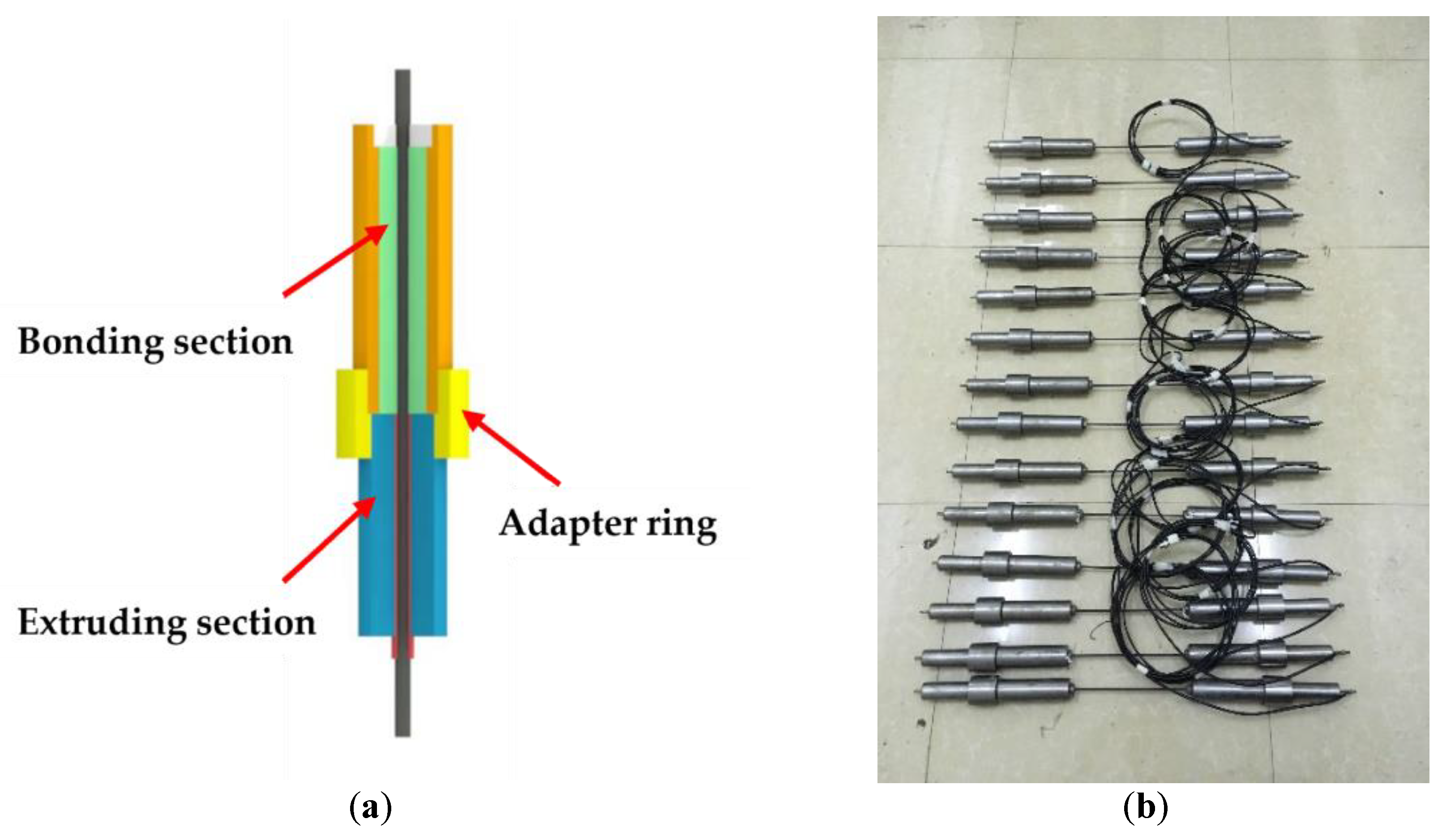

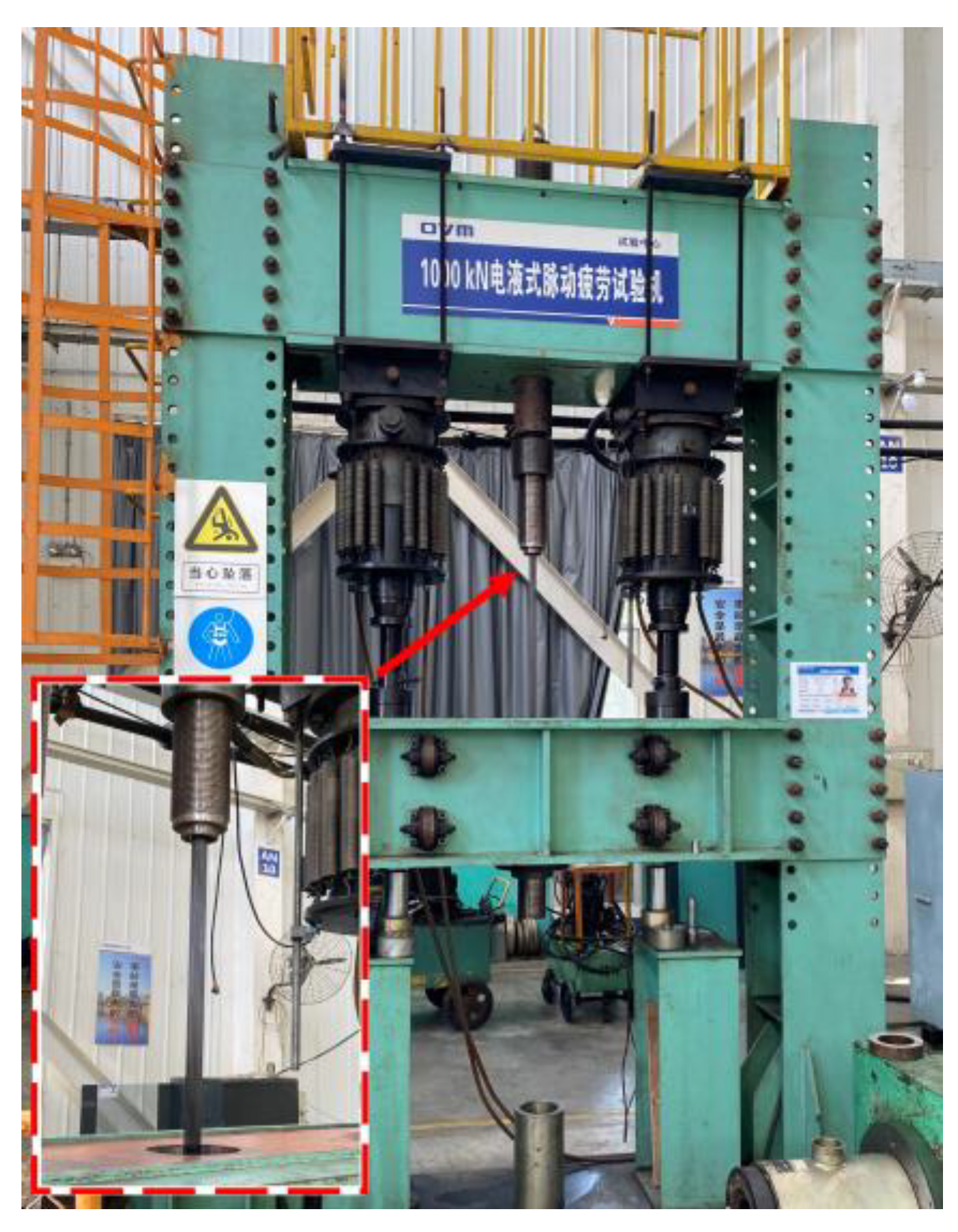


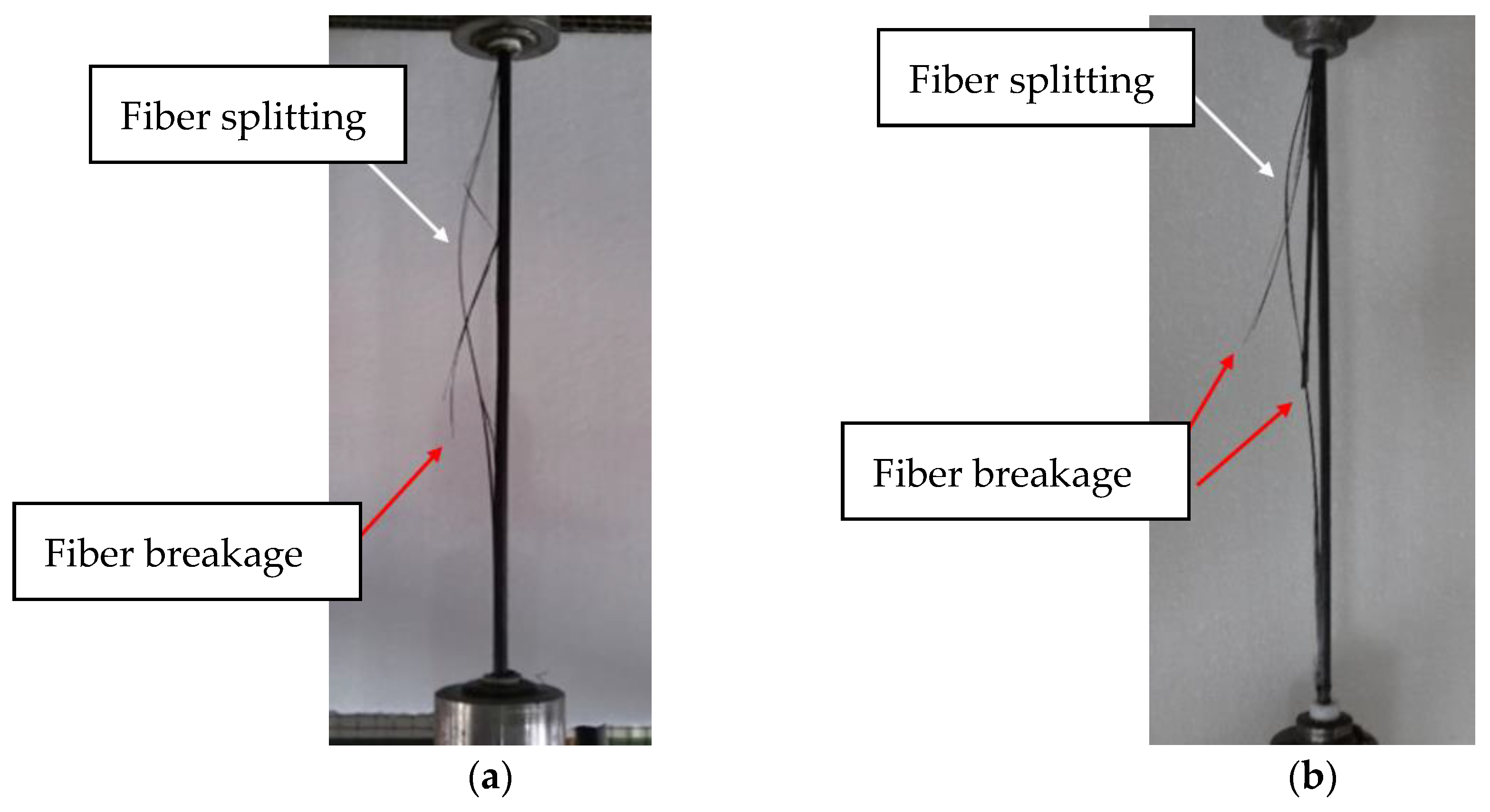
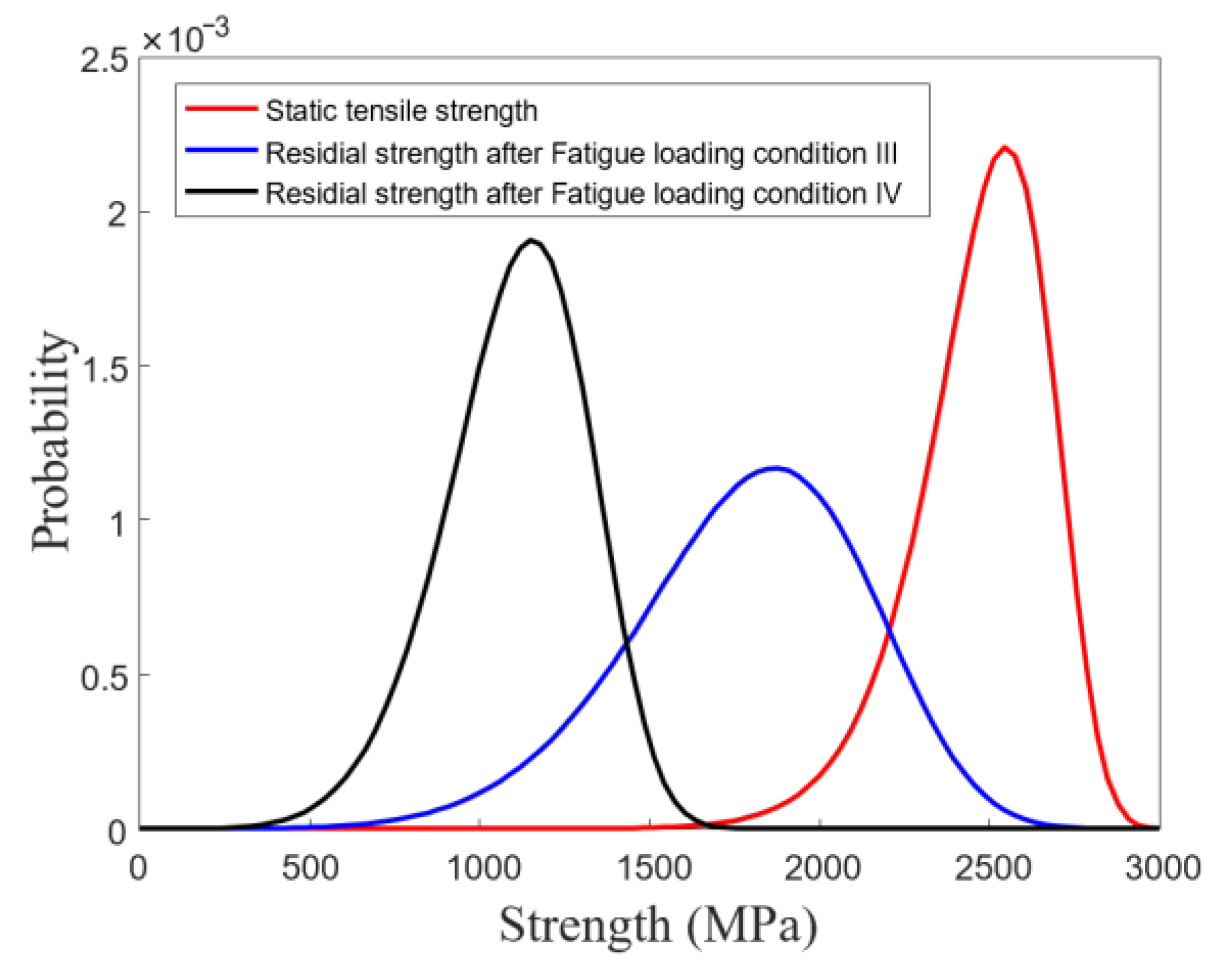
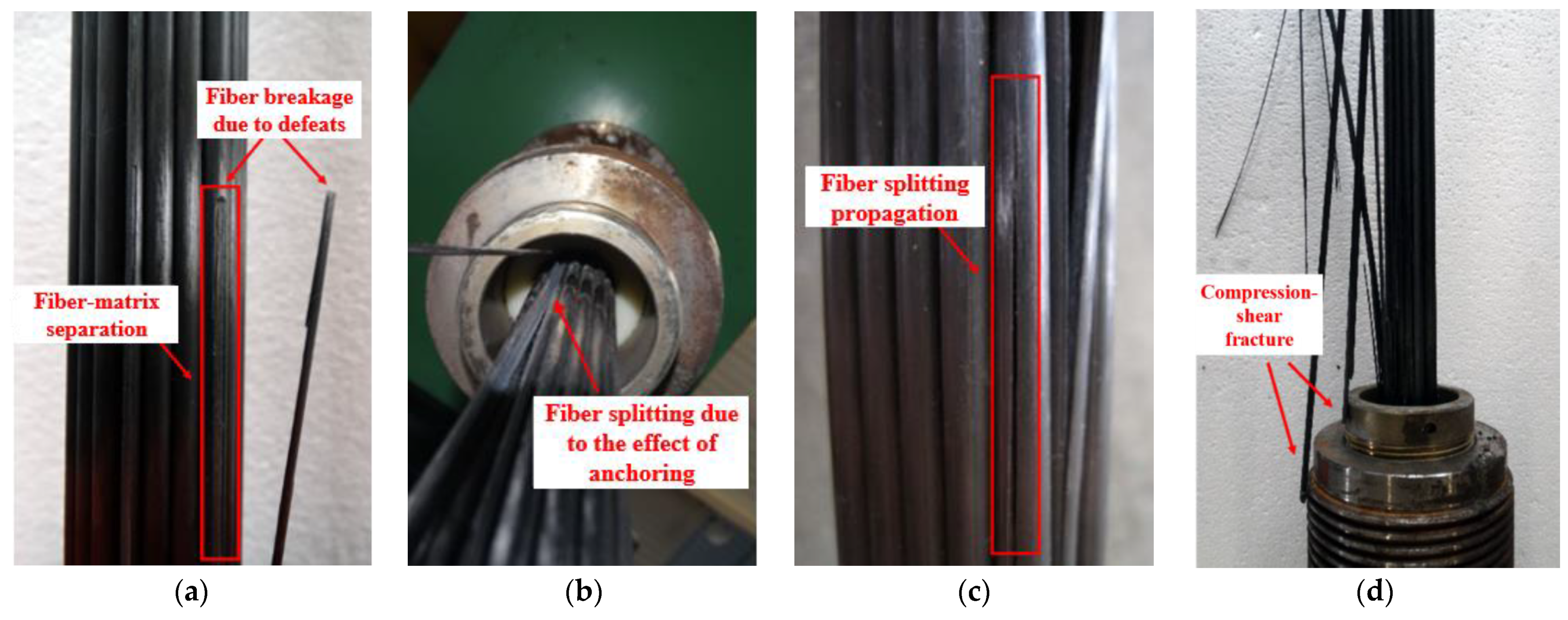

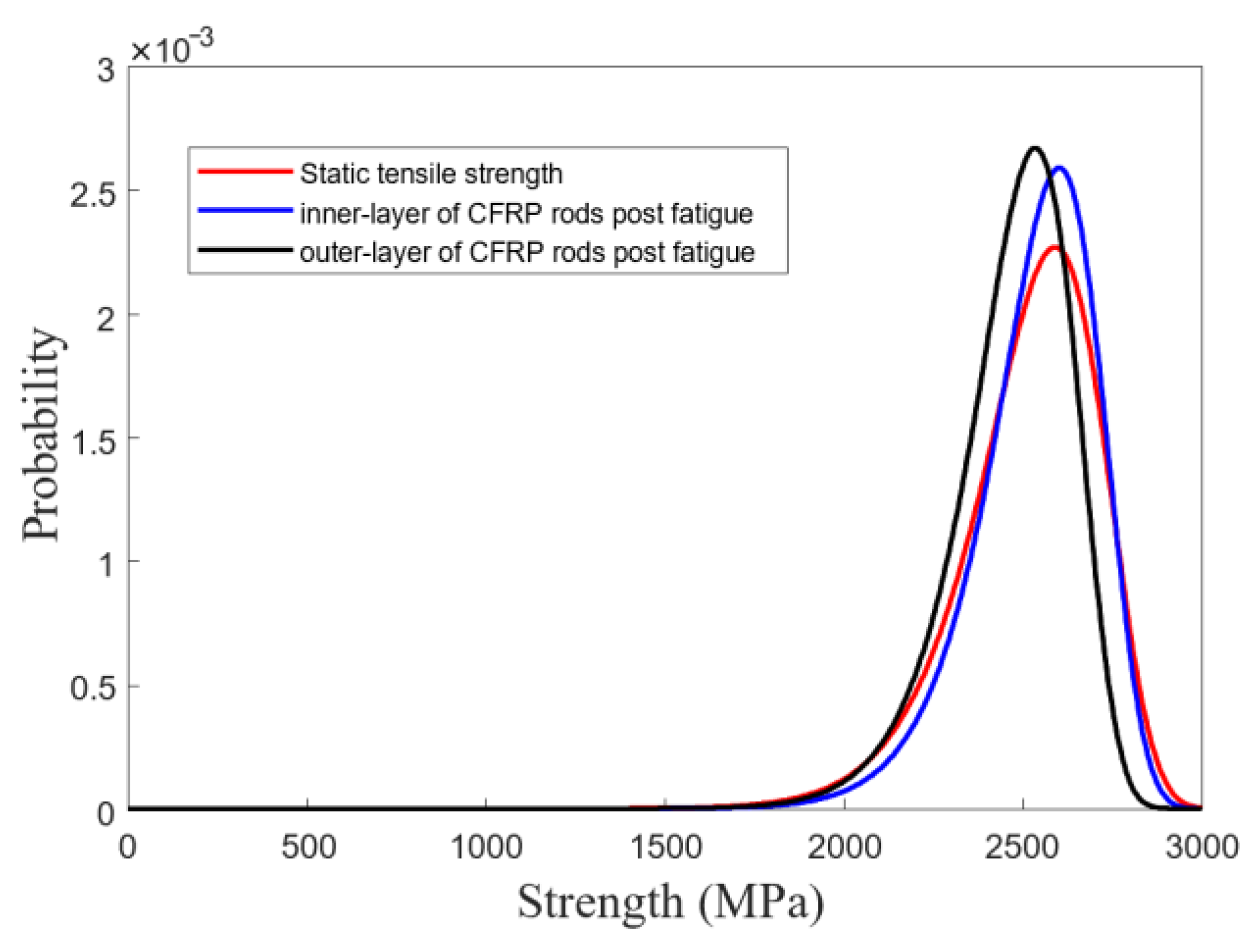
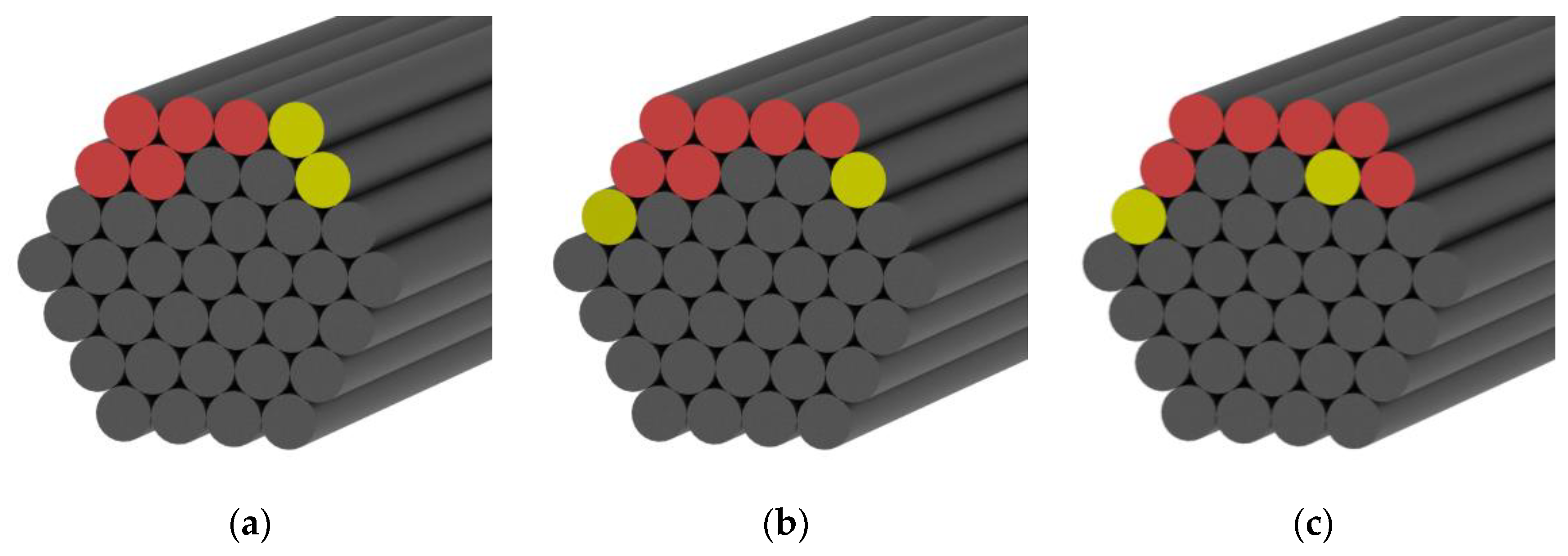
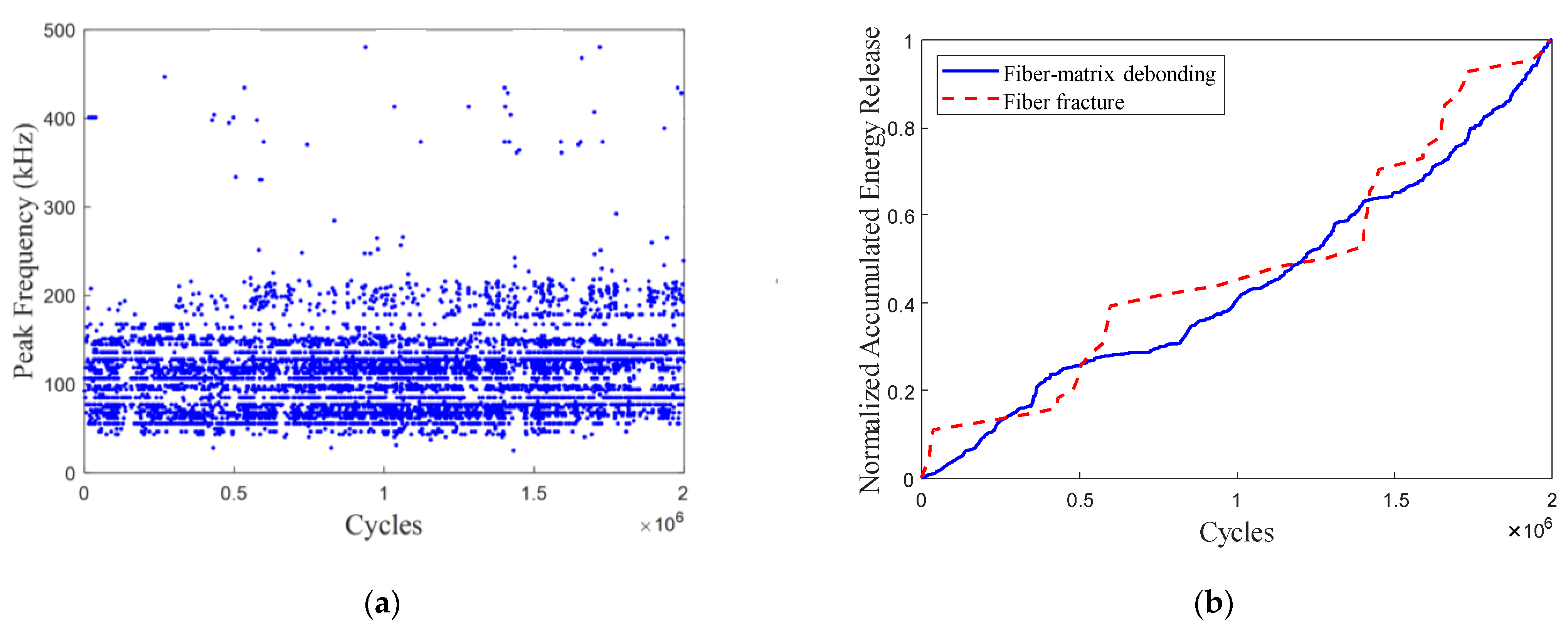
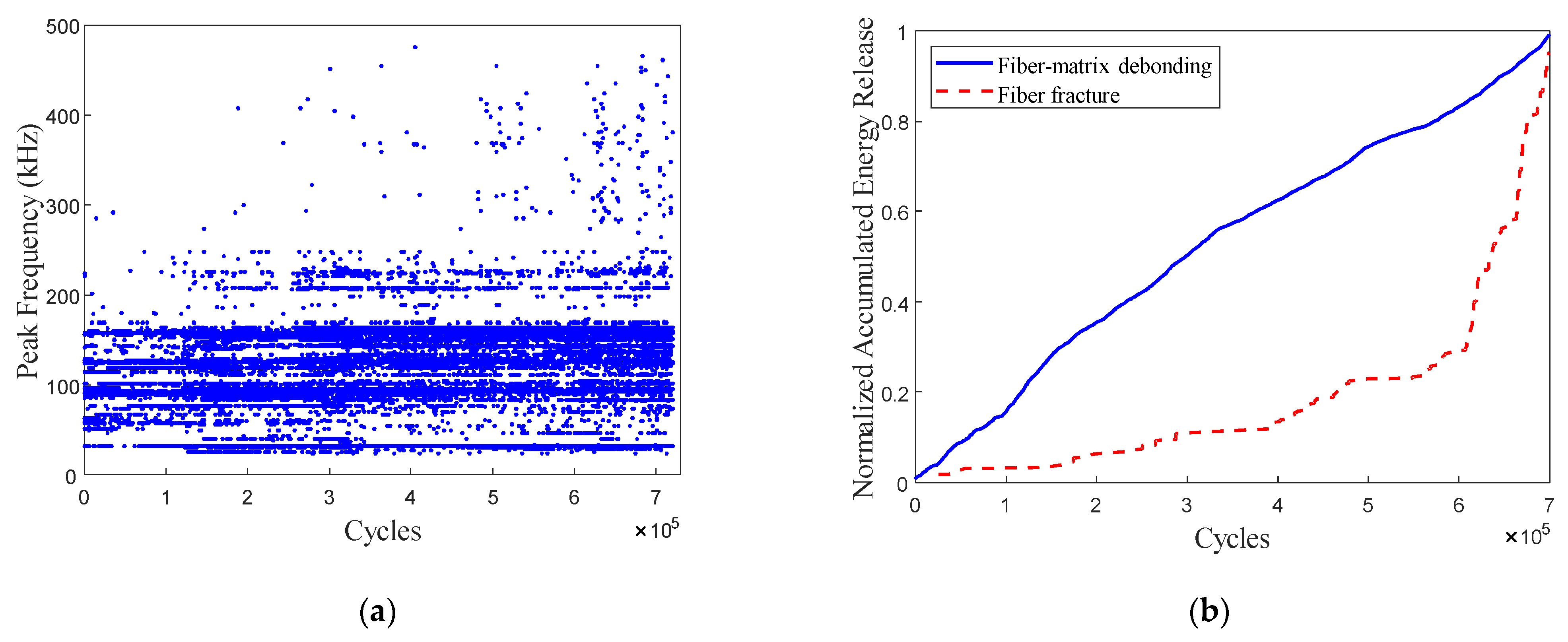



| Material Type | Tensile Strength (MPa) | E-Modulus (GPa) | Elongation (%) |
|---|---|---|---|
| CFRP rod | 2587 | 130 | 1.6 |
| Fatigue-Loading Condition | σmax (MPa) | σa (MPa) | Loading Frequency (Hz) | Number of Test Specimens |
|---|---|---|---|---|
| FLC-I | 0.4 σult | 500 | 4 | 3 |
| FLC-II | 0.6 σult | 500 | 4 | 3 |
| FLC-III | 0.6 σult | 600 | 4 | 6 |
| FLC-IV | 0.8 σult | 800 | 4 | 6 |
| Initialization of Fiber Splitting | Compression-Shear Fracture of CFRP Rods | Terminated Fatigue Loading | |
|---|---|---|---|
| Cable #1 | - | - | 2 million |
| Cable #2 | 743,100–743,800 | 1,430,420–1,430,450; 1,570,160–1,570,187 | 1,570,187 |
| Cable #3 | 312,300–312,800 | 410,240–410,250 | 680,158 |
| Cable #4 | - | 35–40; 4585–4596; 7310–7324 | 7324 |
Disclaimer/Publisher’s Note: The statements, opinions and data contained in all publications are solely those of the individual author(s) and contributor(s) and not of MDPI and/or the editor(s). MDPI and/or the editor(s) disclaim responsibility for any injury to people or property resulting from any ideas, methods, instructions or products referred to in the content. |
© 2023 by the authors. Licensee MDPI, Basel, Switzerland. This article is an open access article distributed under the terms and conditions of the Creative Commons Attribution (CC BY) license (https://creativecommons.org/licenses/by/4.0/).
Share and Cite
Wu, J.; Zhu, Y.; Li, C. Experimental Investigation of Fatigue Capacity of Bending-Anchored CFRP Cables. Polymers 2023, 15, 2483. https://doi.org/10.3390/polym15112483
Wu J, Zhu Y, Li C. Experimental Investigation of Fatigue Capacity of Bending-Anchored CFRP Cables. Polymers. 2023; 15(11):2483. https://doi.org/10.3390/polym15112483
Chicago/Turabian StyleWu, Jingyu, Yongquan Zhu, and Chenggao Li. 2023. "Experimental Investigation of Fatigue Capacity of Bending-Anchored CFRP Cables" Polymers 15, no. 11: 2483. https://doi.org/10.3390/polym15112483





